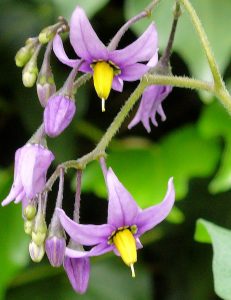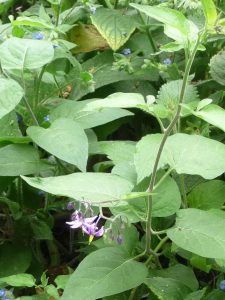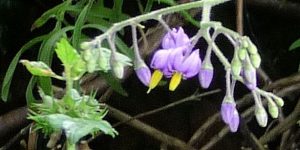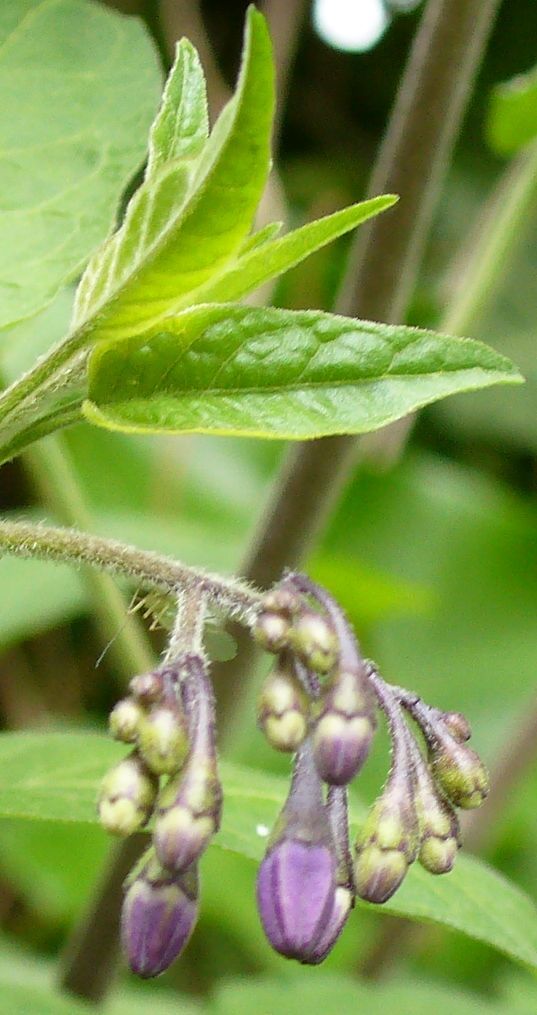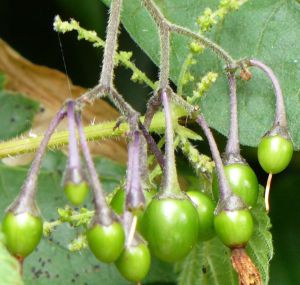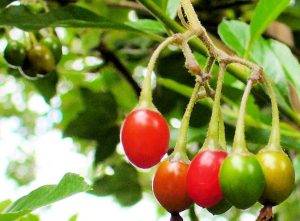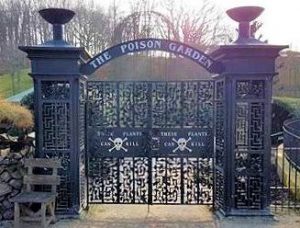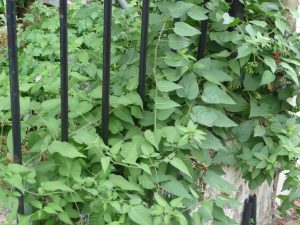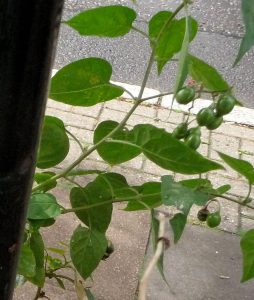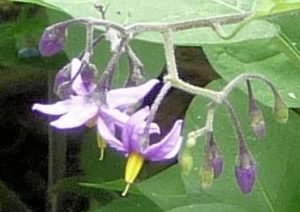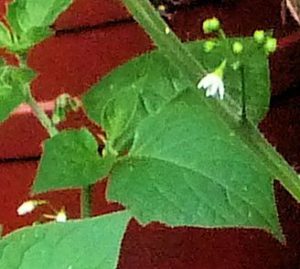BITTERSWEET (Solanum dulcamara)
Europe, Asia and North Africa
Bittersweet is a perennial climber, a woody vine that can be seen scrambling over other plants in UK hedgerows & blanketing them with a curtain of dark green leaves.
Solanum dulcamara will get its roots down into chalk, loam, clay, sand, & crevices between paving stones. It prefers a spot in full sun to part shade, with soil that is moist but well-drained. It will climb, with support, to 2 – 4 metres.
From midsummer to mid-autumn PURPLE star flowers appear, dangling free of the plant with their YELLOW beaks pointing downwards.
Bees Favourite.
Bees pay the Bittersweet constant attention over its long flowering season, seeking out the star-shaped flowers for nectar.
Once pollinated, the flowers become berries – green at first, then changing to RED. They look like tiny tomatoes. These berries may be harmful to humans if eaten. They are part of the diet of some birds, such as European Thrushes.
RED. They look like tiny tomatoes. These berries may be harmful to humans if eaten. They are part of the diet of some birds, such as European Thrushes.
Meaning of the Latin Name
Linnaeus gave this plant its name in 1753. The genus name ‘solanum’ is from Latin ‘solamen, solari, solor’ (‘I comfort, I console, I ease’), referring to the plant’s medicinal and sedative properties. ‘Dulcamara’ – dulcis-amara means ‘sweet-bitter’ – putting branches, berries or leaves of Bittersweet in the mouth will leave first a sweet taste, followed by a bitter one. Monaco Nature Encyclopedia
Where It Grows
Bittersweet grows in woodland, hedgerows, marshes, swamps, pond edges, scrub, riverbanks, thickets, roadsides and disturbed areas.
“this scrambling plant trails itself through hedgerows and scrub and is also to be found on maritime shingle…” www.wildflowersofireland.net/plant_detail.php?id_flower=29&wildflower=bittersweet
Herbal and Historical
Solanum dulcamara has been valued by herbalists since ancient Greek times. In the Middle Ages the plant was thought to be effective against witchcraft, and was sometimes hung around the neck of cattle to protect them from the “evil eye“.
Therapeutic
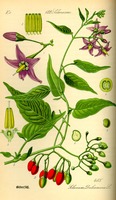 John Gerard‘s Herball (1597) states that “the juice is good for those that have fallen from high places, and have been thereby bruised or beaten, for it is thought to dissolve blood congealed or cluttered anywhere in the intrals and to heale the hurt places.”
John Gerard‘s Herball (1597) states that “the juice is good for those that have fallen from high places, and have been thereby bruised or beaten, for it is thought to dissolve blood congealed or cluttered anywhere in the intrals and to heale the hurt places.”
Wikipedia cites biological uses of Bittersweet against chronic eczema, E.Coli & ringworm.
The dried stem, usually collected in the autumn & preferably from the ends of branches 2-3 years old, is the part most valued medicinally. The leaves are also used to treat skin diseases, arthritis, rheumatism, bronchial congestion, heart ailments, ulcerative colitis & jaundice.
‘A homeopathic remedy is made from the fresh, green, still pliant stems and leaves, harvested as the plant begins to flower. This is used in treating a variety of complaints including backaches, cough, diarrhoea, eye inflammations and joint pains.’ Alainn Tarot
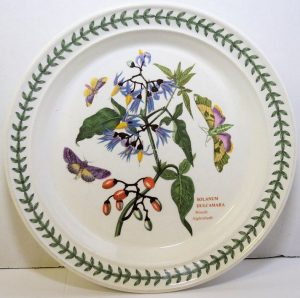
Portmeirion Botanic Garden, 8.5 Woody Nightshade Solanum with laurel border. From a service intoduced in 1972.
Dulcamara uses, benefits
… widely used as a homeopathic therapy for different health conditions, it has been used traditionally to treat arthritis, influenza & headache. Bittersweet belongs to the nightshade family, which includes edible plants such as tomatoes, potatoes & aubergines. Commonly eaten nightshades are believed to reduce inflammation, help heal psoriasis, & treat arthritis.
Dulcamara is most often taken as a plll, dissolving tablet or liquid, or applied to the skin as a cream, gel or tincture. HEALTHLINE https://www.healthline.com/health/dulcamara
Toxic
‘This is a poisonous plant that, in excess, paralyzes the central nervous system, slows the heart & respiration, & lowers temperature, causing vertigo, delirium, convulsions & death. Alainn Tarot
Wear gloves when handling this plant. The unripe green berries are more poisonous than the ripe red ones, but all of the plant is toxic. Children are likely be attracted to the bright red berries, which look like sweets. The plant’s leaves and fruits contain glykoalkaloids that, if ingested, affect the nervous system: burning throat, nausea, dizziness, convulsions, muscle weakness, paralysis. Monaco Nature Encyclopedia – Mozilla Firefox
https://www.youtube.com/watch?v=uIltQx8d1Ds Bittersweet Nightshade Ninja Gardening Brett Episode 13
Dulcamara side effects
Poisonous members of the nightshade family, such as belladonna & dulcamara, are both used in homeopathic medicine. ‘You should avoid contact with these plants if you find them in nature. Contact can irritate your skin. All parts of these plants, including the leaves and fruits, are poisonous. Eating the plants found in nature may lead to nausea vomiting diarrhea slowed heart rate paralysis of the nervous system death. HEALTHLINE https://www.healthline.com/health/dulcamara
Alnwick Poison Garden
The Poison Garden of Alnwick Castle (Harry Potter/Hogwarts) includes nearly 100 of the most deadly plants on the planet.
Many of these lethal plants had to be brought back to the UK from abroad – others are grown in parks & gardens all over the country, with their lethal properties largely unknown to gardeners.
The Bittersweet flower (close-up right) in the article below must mean that Solanum dulcamara has a place in this famous Poison Garden.
.
The Poison Garden of Alnwick Castle by Yvonne Michie Horn, 2016 https://britishheritage.com/the-poison-garden-of-alnwick-castle/ British Heritage Top 10 Things to do in Alnwick
Enter the Deadliest Garden in the World – https://www.youtube.com/watch?v=tboW11dMeKs
Other names: Amara dulcis, Bitter nightshade, Bittersweet nightshade, Blue bindweed, Climbing nightshade, Dwale, Felonwood, Fellenwort, Fevertwig, Fool’s cap, Fuath dubh (Irish), Poisonberry, Poisonflower, Red Tadpole Vine, Scarlet berry, Skawcoo, Snakeberry, Tether-devil, The Devil’s Grapes, Trailing nightshade, Violet-bloom, Wild Potato Flower, Wolfgrape, Woody nightshade
Invasive
http://www.na.fs.fed.us/fhp/invasive_plants/weeds/bittersweet-nightshade.pdf
Highbury Bittersweet
The Bittersweet climber in the Northeast corner of our back garden was there for years, growing some two metres high.
It had not been planted by RF, but like a few other self-seeded plants he let it grow where its seed had been blown or dropped by a bird. Bees loved it.
In 2016 a new, self-seeded Bittersweet vine appeared at the front of the house, climbing vigorously through our garden railings, getting midday to evening sun, facing west. When flowering time came the plant was quickly discovered by bees.
Bittersweet 2022
After several years with spells of drought & extreme heat, Solanum dulcamara looks to be regretting its position in the front garden. This summer there were fewer flowers for the bees, but still they remember to investigate the plant on their way to other neighbourhood gardens.
Black Nightshade
Solanum nigrum
In August 2019 a relative of Bittersweet – Black Nightshade – appeared in our garden near the back fence, where plantlife had been left to grow wild. Its cousin Deadly Nightshade (Belladonna) has the reputation of being most toxic in the family, but Black Nightshade is also one to be treated wth caution. It was given the name ‘strychnos’ by Pliny the Elder. Unlike its cousin Bittersweet – which is a Bees’ Favourite – not a single pollinator has yet been seen showing any interest in its small white flowers.
Edible
Julia’s Edible Weeds, a New Zealand website, says that Black Nightshade’s berries are edible when black (but NOT when green)… & its young plants are edible, when taken from clean, unsprayed ground. The Maori & people from Eurasia & India have no problems with Black nightshade as a food plant. It was listed as a ‘famine food plant’ in Chna in the 1500’s. In Greece and Turkey young leaves and berries are steamed with other leaves in a dish called horta.
Wikipedia: https://en.wikipedia.org/wiki/Solanum_nigrum
